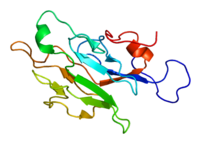
Photo from wikipedia
A recently discovered post-translational modification of histone proteins is the irreversible proteolytic clipping of the histone N-terminal tail domains. This modification is involved in the regulation of various biological processes,… Click to show full abstract
A recently discovered post-translational modification of histone proteins is the irreversible proteolytic clipping of the histone N-terminal tail domains. This modification is involved in the regulation of various biological processes, including the DNA damage response. In this work, we used chemical footprinting to characterize the structural alterations to nucleosome core particles (NCPs) that result from a lack of a histone H2B or H3 tail. We also examine the influence of these histone tails on excision of the mutagenic lesion 1,N6-ethenoadenine (εA) by the repair enzyme alkyladenine DNA glycosylase. We found that the absence of the H2B or H3 tail results in altered DNA periodicity relative to that of native NCPs. We correlated these structural alterations to εA excision by utilizing a global analysis of 21 εA sites in NCPs and unincorporated duplex DNA. In comparison to native NCPs, there is enhanced excision of εA in tailless H2B NCPs in regions that undergo DNA unwrapping. This enhanced excision is not observed for tailless H3 NCPs; rather, excision is inhibited in more static areas of the NCP not prone to unwrapping. Our results support in vivo observations of alkylation damage profiles and the potential role of tail clipping as a mechanism for overcoming physical obstructions caused by packaging in NCPs but also reveal the potential inhibition of repair by tail clipping in some locations. Taken together, these results further our understanding of how base excision repair can be facilitated or diminished by histone tail removal and contribute to our understanding of the underlying mechanism that leads to mutational hot spots.
Journal Title: Biochemistry
Year Published: 2021
Link to full text (if available)
Share on Social Media: Sign Up to like & get
recommendations!